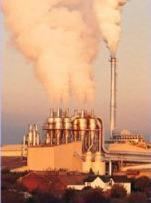 | ||
An emission intensity is the average emission rate of a given pollutant from a given source relative to the intensity of a specific activity; for example grams of carbon dioxide released per megajoule of energy produced, or the ratio of greenhouse gas emissions produced to gross domestic product (GDP). Emission intensities are used to derive estimates of air pollutant or greenhouse gas emissions based on the amount of fuel combusted, the number of animals in animal husbandry, on industrial production levels, distances traveled or similar activity data. Emission intensities may also be used to compare the environmental impact of different fuels or activities. The related terms emission factor and carbon intensity are often used interchangeably, but "factors" exclude aggregate activities such as GDP, and "carbon" excludes other pollutants. One commonly used figure is carbon intensity per kilowatt-hour, or CIPK, which is used to compare different sources of electrical power.
Contents
Estimating emissions
Emission factors assume a linear relation between the intensity of the activity and the emission resulting from this activity:
Emissionpollutant = Activity * Emission Factorpollutant
Intensities are also used in projecting possible future scenarios such as those used in the IPCC assessments, along with projected future changes in population, economic activity and energy technologies. The interrelations of these variables is treated under the so-called Kaya identity.
The level of uncertainty of the resulting estimates depends significantly on the source category and the pollutant. Some examples:
Carbon intensity of regions
The following tables show carbon intensity of GDP in market exchange rates (MER) and purchasing power parities (PPP). Units are metric tons of carbon dioxide per thousand year 2005 US dollars. Data are taken from the US Energy Information Administration. Annual data between 1980 and 2009 are averaged over three decades: 1980-89, 1990–99, and 2000–09.
In 2009 CO2 intensity of GDP in the OECD countries reduced by 2.9% and amounted to 0.33 kCO2/$05p in the OECD countries. ("$05p" = 2005 US dollars, using purchasing power parities). The USA posted a higher ratio of 0.41 kCO2/$05p while Europe showed the largest drop in CO2 intensity compared to the previous year (−3.7%). CO2 intensity continued to be roughly higher in non-OECD countries. Despite a slight improvement, China continued to post a high CO2 intensity (0.81 kCO2/$05p). CO2 intensity in Asia rose by 2% during 2009 since energy consumption continued to develop at a strong pace. Important ratios were also observed in countries in CIS and the Middle East.
Carbon intensity in Europe
Total CO2 emissions from energy use were 5% below their 1990 level in 2007. Over the period 1990–2007, CO2 emissions from energy use have decreased on average by 0.3%/year although the economic activity (GDP) increased by 2.3%/year. After dropping until 1994 (−1.6%/year), the CO2 emissions have increased steadily (0.4%/year on average) until 2003 and decreased slowly again since (on average by 0.6%/year). Total CO2 emissions per capita decreased from 8.7 t in 1990 to 7.8 t in 2007, that is to say a decrease by 10%. Almost 40% of the reduction in CO2 intensity is due to increased use of energy carriers with lower emission factors Total CO2 emissions per unit of GDP, the “CO2 intensity”, decreased more rapidly than energy intensity: by 2.3%/year and 1.4%/year, respectively, on average between 1990 and 2007.
Carbon Intensity in 2012
Commodity Exchange Bratislava (CEB) has calculated carbon intensity for Voluntary Emissions Reduction projects carbon intensity in 2012 to be 0,343 tn/MWh.
Emission factors for greenhouse gas inventory reporting
One of the most important uses of emission factors is for the reporting of national greenhouse gas inventories under the United Nations Framework Convention on Climate Change (UNFCCC). The so-called Annex I Parties to the UNFCCC have to annually report their national total emissions of greenhouse gases in a formalized reporting format, defining the source categories and fuels that must be included.
The UNFCCC has accepted the Revised 1996 IPCC Guidelines for National Greenhouse Gas Inventories, developed and published by the Intergovernmental Panel on Climate Change (IPCC) as the emission estimation methods that must be used by the parties to the convention to ensure transparency, completeness, consistency, comparability and accuracy of the national greenhouse gas inventories. These IPCC Guidelines are the primary source for default emission factors. Recently IPCC has published the 2006 IPCC Guidelines for National Greenhouse Gas Inventories. These and many more greenhouse gas emission factors can be found on IPCC's Emission Factor Database. Commercially applicable organisational greenhouse gas emission factors can be found on the search engine, EmissionFactors.com.
Particularly for non-CO2 emissions, there is often a high degree of uncertainty associated with these emission factors when applied to individual countries. In general, the use of country-specific emission factors would provide more accurate estimates of emissions than the use of the default emission factors. According to the IPCC, if an activity is a major source of emissions for a country ('key source'), it is 'good practice' to develop a country-specific emission factor for that activity.
Emission factors for air pollutant inventory reporting
National Air Pollution Emission Inventories are required annually under the provisions of the UNECE Convention on Long-Range Transboundary Air Pollution (LRTAP). Emission estimation methods and the associated emission factors for air pollutants have been developed by the EMEP Task Force on Emission Inventories and Projections (TFEIP) and are published in the EMEP/CORINAIR Emission Inventory Guidebook.
Intensity targets
The U.S. plans to cut carbon intensity per dollar of GDP by 18% by 2012. This has been criticised by the World Resources Institute as this approach does not ensure absolute reductions if GDP grows faster than intensity declines.
From 1990 to 2000, the carbon intensity of the U.S. economy declined by 17%, yet total emissions increased by 14%. In 2002, the U.S. National Environmental trust labelled carbon intensity, "a bookkeeping trick which allows the administration to do nothing about global warming while unsafe levels of emissions continue to rise."
